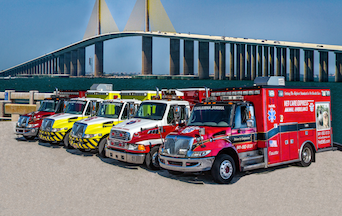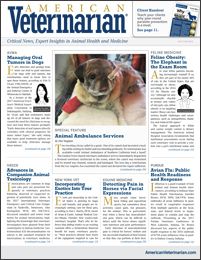Animal Ambulance Services
Whether for emergencies or pet transport, being affiliated with a veterinary ambulance service can be a boon to your business.

The traveling circus called in a panic. One of its camels had lacerated a back leg while exiting its trailer and was bleeding profusely. No veterinarian was available—could Animal Ambulance of Southern California lend a hand?
The Garden Grove—based veterinary ambulance service immediately dispatched a licensed veterinary technician to the scene, where the camel was restrained and its wound was cleaned, sutured, and bandaged.
The next day, a veterinarian from the Los Angeles Zoo examined the camel and declared the repair sufficient.
Sewing up an injured camel is unusual, but this story illustrates the eclectic nature of the cases that veterinary ambulance services may encounter on any given day. More commonly, they transport ailing pets from their owners’ homes to the veterinarian or from a primary care practice to an emergency clinic. Some also help with in-home pet euthanasia, work with first responders to treat animals affected by fires and other disasters, and assist police and other agencies in cases of animal mistreatment.
RELATED:
- How to Approach Emergency Cases in the Veterinary Setting
- Why Cats May Need Emergency Care
AmbuVet Pet Ambulance, one of the largest pet transport services in New York City, is a good example of a multiservice company. Based in Jackson Heights, the company was founded in the aftermath of the terrorist attacks on September 11, 2001, said owner Don Montes. As rescue dogs started to arrive in New York City from around the country, Montes, a licensed veterinary technician, decided to help by collecting food and supplies from area veterinary clinics and delivering them to the disaster site. He and colleagues then stayed to assist until the Federal Emergency Management Agency arrived with its own veterinarians and technicians.
“After that, I felt something needed to be done because at that time there were no ambulance services for animals,” Montes recalled. “As a licensed technician, I felt it was my responsibility to at least try.” Additional veterinary ambulance services have popped up in New York and other cities in recent years, but overall growth has been relatively limited nationwide. The majority of current businesses serve larger metropolitan areas, although some also cover rural regions. Local and state laws regulate what services they can and cannot provide.

Some companies, such as AmbuVet and Animal Ambulance of Southern California, employ licensed veterinary technicians, which enables them to provide in-transit medical support such as pulse oximetry, ventilation, intravenous administration of medications or fluids, and suction. Others, such as Vet Care Express Animal Ambulance in Bradenton, Florida, and Pet EMT Animal Ambulance and Transport Service in Raleigh, North Carolina, do not employ licensed technicians and provide basic transport only.
Most pet ambulance services use ambulances for humans that have been refitted to accommodate animal patients. (Unlike their human counterparts, however, they are not permitted to turn on their sirens or run red lights.) Dogs and cats are their most common patients, but most companies report transporting a wide range of species. “We’ve had hamsters and llamas and everything in between,” said Andy Berg, manager of Animal Ambulance of Southern California. “We also have a contract with a regional laboratory to pick up animals for necropsy. Not too long ago we picked up a Sumatran tiger from a big-cat rescue to take down for necropsy.”
Most transport cases are relatively mundane, but sometimes crews nd themselves dealing with truly tragic situations. Montes recalled responding to the filming of a reality show during which 2 dogs, apparently distracted by the film crew and equipment, leaped from the roof of a building. One dog was impaled on a tree, but the other landed on a wooden table, which helped to break its fall. Although severely injured, that dog survived, Montes reported. On a lighter note, AmbuVet also assisted in reconnecting pets with their owners in the aftermath of Hurricane Sandy, a job that brought Montes great joy.
Another important aspect of the job is assisting pet owners. “Whatever someone needs, we’re available to help with,” observed Cheryl Brady, owner of Vet Care Express Animal Ambulance. “For example, we get called to a lot of homes because people can’t capture their cat, so we’ll capture the cat for them. Some still want to transport their pet themselves, while others want us to transport, especially if the owner is disabled or can’t take a chance on being bitten or scratched due to illness.”
Don Money, owner of Pet EMT Animal Ambulance and Transport Service, was once hired to drive to Washington, DC, to pick up a dog with diabetes owned by a diplomat who was concluding a tour of duty in China. “They could have own the dog to Raleigh, but it would have meant the dog going 12 hours between insulin shots,” Money noted. “They wanted someone to drive to DC, administer the insulin, and then drive the dog back to Franklin County, North Carolina. We were able to do all of that for them.” How Veterinarians Benefit
For veterinarians, the benefits of working with an animal ambulance service can be many, transport owners say. Not only do the services deliver patients to their door, but technicians and other personnel can provide a preliminary set of eyes on the patient, its owners, and the home environment, conveying to doctors information and insight that can have an important impact on patient care.

“It’s important for veterinarians to understand that we are an extension of their services,” observed Montes. “We take an assessment of the situation, get a complete medical history, and call the veterinary hospital en route to let them know what is coming in so they can be prepped and ready.”
Practices also benefit by hiring ambulance services to take critically ill patients to nearby emergency or specialty facilities, added Berg. “In the past, they used to have the owner drive the animal to the emergency clinic,” he explained. “Now they have the option of continued care in an ambulance. Oxygen, IV fluids, pain meds, and more can all be delivered during transport.”
Noted Brady, “This can be an income generator for a veterinary clinic. We have a lot of practices that want to be associated with us because it gives them that extra specialty of service.”
A small number of veterinary practices have their own ambulance transport service. Among them is WestVet Emergency and Specialty Center in Garden City, Idaho, which uses its ambulance primarily to transport patients from other veterinary facilities, said Dan Hume, DVM, DACVIM, DACVECC, chief of emergency and critical care at WestVet. WestVet employs its ambulance infrequently—maybe once every couple of weeks—but Dr. Hume acknowledged the value that offering such a service can bring to a practice.
“From a marketing standpoint, it’s great because the ambulance is a visible thing that has our name on the side of it,” Dr. Hume reported. “We also utilize it for a lot of special events, such as pet expos and open houses. Kids get to tour the ambulance and spend time on it. So from a business marketing perspective, it is a very good tool. From a medical standpoint, the ambulance allows us to transport very sick patients and get them in the hands of our team of specialists, which hopefully means a positive outcome for those patients.”
Looking to the Future
The future of veterinary ambulance services is difficult to predict. There definitely is a need, said Berg, but the survival of such services is often predicated on the economy. When times are good, people are more inclined to spend money on their pets; when times are bad, dif cult choices often must be made. “I think those who have the means will continue to use veterinary transport services,” Berg said, “but the economy is an important factor.”
